1
Steamboat port of Gordon CreekOctober 1919
Temiscaming, Quebec, Canada
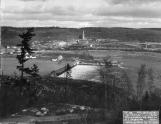 Credits:
Credits:Temiskaming Shores Public Library Archives
2
In the late 1800's the only way to reach the Little Clay Belt from the south was by boat, traversing the eighty-mile length of Lake Temiskaming (part of the Ottawa River system) by way of Gordon Creek. Travellers from southern or eastern Ontario could travel by rail from Mattawa to Gordon Creek (now South Temiscamingue) which was situated at the south end of the lake.3
The small tug the "Wabis" booming up1900
Lake Temiskaming, Ontario, Canada
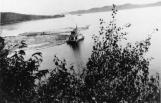 Credits:
Credits:Temiskaming Shores Public Library Archives
4
By the time the first settlers started arriving at the Little Clay Belt in 1891, the lake was already a well-established waterway. For centuries, the aboriginal peoples had crossed the lake with birch bark canoes, followed later by the trappers and fur traders. Logging camps and lumber mills were operating on both the Quebec and Ontario sides of Lake Temiskaming during the latter part of the 1800's and they relied on steam tug boats to bring supplies and mail, and for towing logs down the lake.The townships of the Little Clay Belt had been surveyed by 1887, and some of the lumbermen, mostly from the Ottawa Valley, took advantage of the cheap, fertile land being offered for sale to homestead in the area. Advertising in promotional brochures which circulated in southern Ontario and word-of-mouth promotion from earlier visitors to the region, resulted in a slow but steady trickle of settlers from the south to the Clay Belt in the 1890's.
5
With no train service or roads into the north, from the 1890's to about 1905, steamboats on Lake Temiskaming, for only several months of the year, were the only way to reach the Little Clay Belt.6
Between sometimes turbulent waters and fluctuating water levels, traversing the lake could be somewhat hazardous or at the very least, uncomfortable. During the winter months, some travelers made the journey on foot, or by horse team and sled over a frozen Lake Temiskaming.7
The Lady Minto, the second largest tugboat to work on the Lake1900
Lake Temiskaming, Ontario, Canada
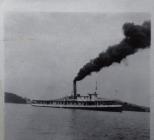 Credits:
Credits:Temiskaming Shores Public Library Archives
8
In the late 1800's, there were several types of steamboats regularly plying Lake Temiskaming. One type of steamer was the tugboat.The Lady Minto was the second-largest tugboat to work on the lake and measured 138 feet in length (the largest was the Alexandria).
The Lady Minto operated on Lake Temiskaming for 65 years, from1903-1968, and in that time, towed booms of logs down the lake.
The tug was able to accommodate 12 crew members who worked six-hour shifts. The living conditions were considered "comfortable" as there was a cook, kitchen, and sleeping quarters on board.
On the trip south on the lake, large tugs like the Minto would tow three booms of logs at a time (also called a "sack") containing as many as 200,000 logs. With 1500 feet of cable holding a mile-long boom together, there was always the threat of a boom breaking up in poor weather conditions and the logs scattering all over the lake.
On the return trip north, the tug would bring back boom timbers or "sticks" and haul up to 70 tons of coal that was placed on a scow and towed in between the timbers. The coal would be used to fuel the boats at the north end of the lake.
The Minto was also the longest operating and the last steamboat to work the lake. In 1968, the boat was burned and sunk to serve as an anchor for a boom.
9
Small Tugs1900
Lake Temiskaming, Ontario, Canada
 Credits:
Credits:Temiskaming Shores Public Library Archives
10
Smaller tugs were used for delivering supplies along the lakes and rivers because they could operate in Lake Temiskaming's shallower tributaries not accessible to the larger tugs.The maneuverability of these boats also allowed them to conduct sweeping operations where logs that escaped from booms being towed on the lake, could be gathered along the shoreline. Tugs like the Wabis and the Ella were sometimes used to pull the floating bunkhouses of the sweep gangs around the lake.
11
The P.J. Murer was a diesel tug1900
Lake Temiskaming, Ontario, Canada
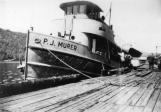 Credits:
Credits:Temiskaming Shores Public Library Archives
12
The P.J. Murer was a diesel tug that went on to replace boats like the Lady Minto and the Alexandria as the main tugboat on the lake. The P.J. Murer was able to perform the same duties as the steam-powered boats, but in a more economical and efficient manner and with a smaller crew.13
The Steamer "Meteor"1910
Lake Temiskaming, Ontario, Canada
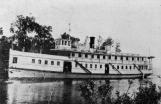 Credits:
Credits:Agricultural Temiskaming, 1910
14
Passenger boats were really put into service in the 1890's, ferrying settlers from Gordon Creek (now South Temiscamingue) to the town sites of Haileybury and New Liskeard on the Ontario shore, and Ville Marie on the Quebec side of the lake.The Meteor started out life as La Minerve but on March 6th, 1888, it was purchased by Alex Lumsden of the Lumsden Steamboat Line. After being rebuilt several times, the Meteor became one of the best-known and most comfortable boats on the lake.
The earliest settlers took great pride in the fact that they had arrived in the Little Clay Belt on the Meteor, as it signified that they were among the original pioneers to the area. This ship, and others like it, was responsible for bringing the new settlers, mail, freight, and tourists to the area. Before the railway and roads were built to connect the south to "New Ontario", as it was known, it was the passenger boats that served as the lifelines for the communities along the shores of Lake Temiskaming.